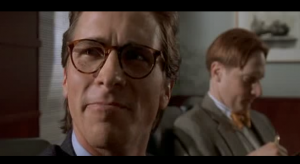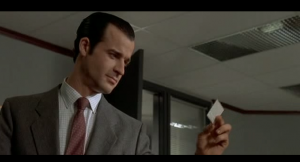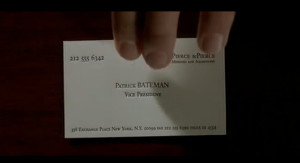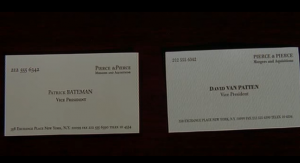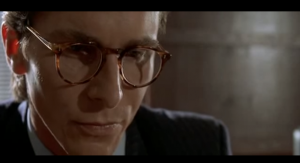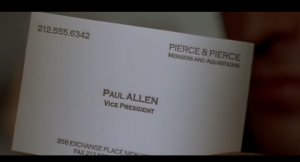Drive, directed by Nicolas Winding Refn, is a neo-noir arthouse action film adapted from a novel by James Sallis going by the same name. The film follows the story of an unnamed Hollywood stunt driver, played by Ryan Goslin, who moonlights as a getaway driver. I love this film because of its style, soundtrack, and the amazing performances by the actors in general. I chose this particular scene because I remember how shocked, moved and breathless I was after seeing it for the first time.
The scene opens with a mid shot of the 3 characters in the elevator. Goslings character presses the button to close the door, steps to the right side of frame revealing Irene (Carey Mulligan) before the door slides closed, the camera pauses on this for a moment. Next, a mid shot of the villain, tilted slightly upwards shows him giving Gosling a sideways glance. Goslings back and Irene profile are both in frame, amplifying the cramped nature of the location, while the tilt implies that something is amiss. The camera cuts to a similar shot of showing Goslings character, which for all intensive purposes could be said to be a reverse shot. A steady tilt down follows Goslings implied point of view as he looks the man down, to rest on his jacket, where a concealed gun is visible. It cuts back to the mid worm eye tilt of Gosling, looking away inconspicuously, yet clearly aware of the situation.


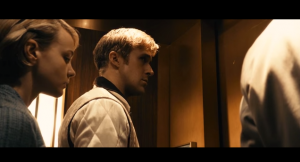
The camera then cuts to a mid to wide shot of the characters in the elevator, with gosling at the centre of the frame. He reaches behind him and gently pushes Irene into the corner of the lift, far away from the other man. As he does this, the light dims. What looks like the whole lift dimming, creating a more intimate tone, is rather the fill light being turned down or off all together. In doing this, The light which remains on screen seems to intensify around Irene’s face as she reacts in confusion to Goslings actions. Cut to a shot of their midriffs as Gosling places his hand around her waist. The camera tilts upwards (or tracks, in this case i’m not sure what the appropriate term is), the camera is most likely hand held. The camera rests on a two shot of the couple kissing intimately. The action is in slow motion, while mellow, ambient music plays in the background, creating a very intimate yet isolated tone, as if they have forgotten about their place in the world. The fill light brightens as they finish their kiss and gaze at each other, signifying a return to reality.
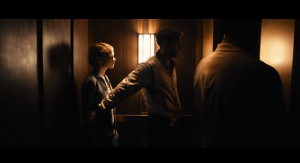

Cut to a wide shot of the lift facing the doors. The music cuts and the action returns to normal speed. Gosling, left of frame, turns his head to look at the other man, standing to the right of frame, who immediately turns to swing a punch at Gosling. Anticipating this, Gosling pushes him in the back and follows through to slam the mans head into the wall. Camera cuts to focus on a mid shot of Gosling, as he throws the man from the right side of the frame to the left. Cut to Irene reacting, frightened and shocked, positioned to the right of the frame, emphasising that she is trapped in the corner. A shot of Gosling throwing the man on the ground is intercut before returning to Irene moving from one side of the elevator to the other, getting herself being Gosling who is in the shot but the top of his head cut out of the frame. Cutting back to the man on the ground, mid shot, shows him blearily moving to stand before a swift kick in the face from Gosling (entering from outside of frame) puts him out of action. We again cut back to the previous shot, Gosling stomps again, his body is silhouetted, transforming him into a figure to be feared, the power behind his stomp is obvious as his knee enters the frame, further assisted by a loud audible crunch, the girl responds to the brutality of the violence. Further emphasising this, the camera cuts to an OTS of the girl as she watches Gosling stomp the mans face in, the scorpion emblem on his back clearly visible, emphasising his transformation in her eyes from love interest to violent man to be feared. A wide angle close up of her reacting, the camera slowly zooms, shaking with fear and possibly grief implies that while she can’t understand the situation, she certainly understands what is happening in front of her eyes. An L cut of the audio of the stomping eases the transition between shots to a worm eye of Gosling stomping, brutally. The anger and aggression on his face transforms the generally placid deadpan character into an explosive force. The camera cuts briefly to the mans skull literally being crushed to the previous shot in which Goslings profile is silhouetted while the focus remains on Irene reacting, before cutting back to the worm eye as he finishes stomping.
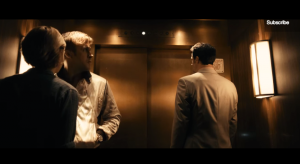
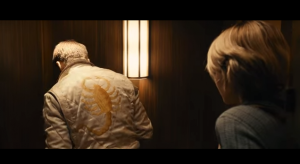



When the stomping ceases, the camera once again cuts to a wide angle mid shot of the girl. The elevator opens and she walks backwards out of it, exiting the frame, putting distance between her and Gosling. Cut again to a mid shot of Gosling, showing his back turned, the scorpion clearly visible on his jacket. He turns slowly, his sweaty face and bleary eyes lend itself to the emotional violent outburst that just happened. Also implicit, is the knowledge that what he did shocked and scared the woman he loves, so there is a hint of remorse and exposure. The reverse shot places Irene in the centre of the frame, in a darkly lit car park, this makes her appear more isolated. facing the camera and in the centre of the frame, this seems to suggest (as is the reality in the movie) that this is the first time she has seen this side of Gosling, and in her eyes who he really is. The camera rests on this shot for a few beats, not to draw suspense but to lend to the shock the character is facing, unable to come to terms with what just occurred. The camera cuts back to Gosling, staring, blood visible on his jacket, then back again. The door closes across Irene as she stands motionless in the centre of frame, signifying the end of the scene and the last time they see one another.
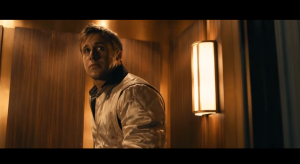

The most obvious thing about this scene is the dramatic contrast between the beautifully intimate kiss shared by Goslings character and Irene, and the gratuitous brutal violence that follows. The on screen action captured in the scene is fantastic as well. Despite the extreme confinement of the lift, all the characters seem move around the entire space, most obviously Irene, who travel from corner to corner, trying to escape the violence. Furthermore, the sound design of the whole scene compliments everything fantastically well. The silence at the beginning builds suspense, the music during the kiss creates a special romantic moment, before cutting out altogether to just have the sounds of slamming and stomping emphasising the unadulterated violence which ensues. The pacing also heightens the drama, opening with a relatively mundane pace as the door closes and the men size up one another. Transitioning to slow motion which goes for about half the length of the scene, as i’ve already mentioned, gives an ethereal romantic tone. Juxtaposing this against the fast paced violence before slowing as he runs out of steam makes for a dramatic and dynamic experience. Finally the scene returns to silence, this time because there are no words the characters can find to address what just happened. No dialogue, just excellent acting, pacing, camera work and sound.
I struggled to find faults or criticise this scene, I’m not quite sure how I would have done it differently. This is most likely because the film is so heavily stylised. One thought that came to mind is the quick cut to the mans head being crushed underfoot, this is the only shot of gruesome violence, and feels somewhat out of place given the extremely short length of the shot. It could have served better to not include it at all, although it does have that cringe factor which compliments the scene. The alternative would be to lengthen the shot, or cut back to it more than once. This might be considered overkill however, and honestly, I like it how it is.

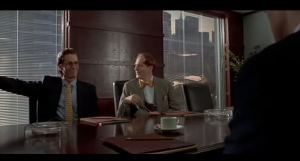

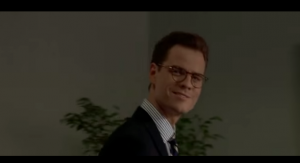 ver begins, explaining the situation. As the voice over happens, there is a cut to Marcus Halbistram, the person Allen confused Bateman for, panning from left to right as he enters the room and shakes hands with a colleague, Halbistram nods in acknowledgement toward the camera as he enters, as if he is acknowledging the voice over talking about him.
ver begins, explaining the situation. As the voice over happens, there is a cut to Marcus Halbistram, the person Allen confused Bateman for, panning from left to right as he enters the room and shakes hands with a colleague, Halbistram nods in acknowledgement toward the camera as he enters, as if he is acknowledging the voice over talking about him.
